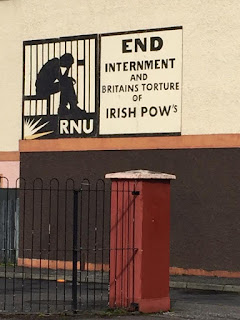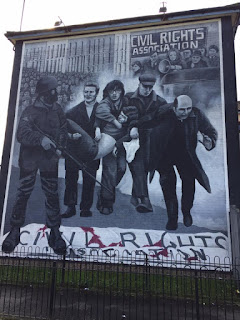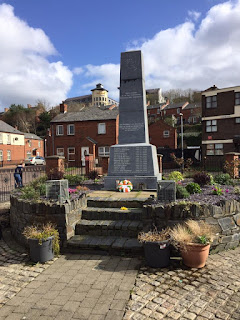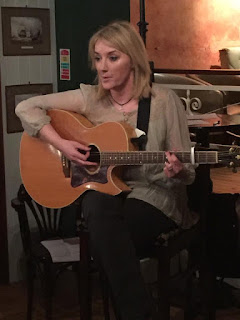Ireland Study Abroad 2017
Central Arizona College students embarked on our first European study abroad program to Ireland during spring break 2017. Professor Karen Hindhede blogged about the experiences on this exciting adventure. #cacireland
Monday, March 27, 2017
Day 12 - Coming to an end...
Day 12 Tuesday: Saying goodbye to our Nebraska friends and Ireland itself was very difficult. Many students told me that this was one of the most incredible experiences they have ever had in their lives. Another told me that coming to Ireland was the best decision he had ever made. There was much time for talking and learning, not just about Ireland and its people and culture, but about each other, and ultimately, our selves. We leave changed, reflecting upon the past, the present, and our place in this world.
Day 11
Day 11 Monday: Dublin! After lunch in the heart of Dublin, we headed to Epic, a fantastic museum combining Irish history and the immigrant story. It was a lovely way to tie together all of the events we have been studying. One more final connection for the program occurred when we stopped at the Dublin Teachers Union building. We walked into this beautiful Georgian style building, and had a poetry reading with Paula Meehan, Ireland's former poet laureate. I had included her in our LIT 206 curriculum, and now students had the opportunity to ask her questions about the poems we had read and discussed! Here we were in a country that values the arts, especially writers and poets—the land of Jonathan Swift, Samuel Beckett, and W.B. Yeats, of James Joyce and Seamus Heaney and now Paula Meehan. And, incredibly, the actual room hosting us was where Joyce, author of Ulysses and The Dubliners, took his piano lessons as a child.
Everyone was then let loose into the city after goodbye hugs and tears with Niahm and John. A small group of us headed to Trinity College, where we viewed the Book of Kells. This is one of the oldest surviving Biblical manuscripts, but its ornate, intricate illustrations, often with Gaelic patterns, are what are especially stunning. In disbelief, we viewed pages from the book dating from 800 A.D. It’s one thing to see burial chambers or stone castles this old, but a book that has been safeguarded all this time? It was awe-inspiring. Afterward, a student and I hurried to Christchurch Cathedral, Dublin's oldest, and then on to Saint Patrick's Cathedral where Jonathan Swift was the dean. There he wrote “A Modest Proposal” and Gulliver’s Travels; he is also buried at the Cathedral.
Days 9 & 10
Day 9 Saturday: Today people slept in or went horseback riding (English style) or cliff jumping. In the afternoon, we went back to Sligo Town for shopping. Besides little purchases, I found the museum where Jack Yeats’ paintings are housed, but the museum closed two hours earlier. (Jack is the brother to the famous W.B poet Yeats.) Many places have winter hours, and most places are not open nearly as late as in the U.S. That evening, we listened to another band at 51 Pub, the pub attached to our hotel, and caught up with each other’s adventures.
Day 10 Sunday: Most people are tired of croissants and fresh fruit for breakfast, though I could live on them forever. (Breakfast also includes a selection of cheeses, meats, and yogurt and cereals.) As we milled around for breakfast, noting the sun was out, it was clear we all were all looking forward to our trip to Londonderry, Northern Ireland today. Today is Niahm’s last lecture, which is truly a disappointment. She has such a fantastic way of bringing the past alive and making it relevant to the world we live in today. Additionally, we are all feeling a mixture of sadness that the trip is coming to a close yet a longing to see our families.
Niahm reminded us multiple times throughout this lesson that the recent conflict between Northern Ireland and the Republic of Ireland, called the Troubles to the Irish, is really not about Protestant versus Catholic. The issue was about civil rights and conflict resolution.
While the majority of the Unionists, who wanted to stay in the British Union are Protestant, not all were; likewise, the Nationalists were majority Catholic but many were Protestants because the poor Protestants had been brought over from English and Scotland and re-settled in Ulster by the British during the Plantation period. Many of them felt very little of allegiance to the British as we well learned given the rise of the Anglo-Irish culture. The Penal Laws were supposed to make Ireland bow to England but they also turned the people away from the Crown. Still, in 1922, the treaty for independence from Britain created two countries: a Republic of Ireland and Northern Ireland which included 6 of the 9 Ulster counties loyal to Britain. (Independence was officially in 1916, but the treaty came in 1922, and it was the first treaty world-wide to specifically include freedoms for men, and women and children.)
The trip in the afternoon started at Londonderry at the Bogside murals. The Bogside is really where the Troubles began in earnest in 1972. From 1926- the 60’s, Northern Ireland was tense and peace between the Unionists and Nationalists was fragile. The Unionists felt threatened that the Republic of Ireland would gobble them up, and they began ensuring they had the best schools, housing, and jobs. They worked to jerry rig the political system, too, to ensure that the Nationalists could not tip the vote into having Northern Ireland join the Republic. When people have no political voice, then they have few civil rights. Additionally, the police force worked to support this system, as did the British who came in to keep order given the growing civil unrest. Communities became more and more segregated, with the Catholic areas more and more ghettoized like the Bogside. Modeled after Martin Luther King Jr.’s peaceful demonstrations, the Bogside community organized a civil rights march to protest the conditions and political situation. That day, the British army, stood at the old city walls overlooking the Bogside and fired into the crowed wounding 40 people and killing 14 people, which we now know as Bloody Sunday.
We walked to each of the 12 Bogside murals, which depict the story of the Troubles. They are huge murals painted on the sides of apartment complexes, and they are stunning in the powerful portrayal of force, pain, and redemption. As one leaves the Bogside and heads upward to the older part of Londonderry inside the walls, the final mural is that of a dove overlaying an oak tree overlaying the same size squares in varying colors. The colors represent all of the shades of the Irish people and counties. It is a beautiful mural, simple and strong. (The oak leaf represents this ancient city. Poets used to preform at the groove of oak trees during Gaelic times, and then the monks during the Christian times built their order there. During the Plantation times, Derry became a fully walled garrison city; thus, the oak leaf captures the full history of city including its place in resolving the Troubles.)
Ireland is the one place in recent history where the peace process has truly worked in bringing together two sides that had such violence and hatred. The U.S. was instrumental in negotiating the peace talks, which resulted in the 1998 Good Friday Peace Agreement. Multiple concessions occurred on both sides, and the British government apologized for the first inquiry that indicated the peace marchers were at fault for Bloody Sunday. Queen Elizabeth also visited Londonderry, spoke in Irish, and laid a wreath commemorating the murders. There has been much healing. It was interesting to see how the Bogside area definitely had more of an IRA feel given leftover signs, flags, and Catholic imagery, but when getting into the old part of Londonderry, we saw more Protestant and British symbols and imagery. Despite reminders of the past, several students spoke to lifelong residents who explained they walk freely now in any part of the city and the violence and sectarianism is gone. Interestingly, there are no longer checkpoints between Ireland and Northern Ireland, but that may change with Britain leaving the European Union.
One of the most powerful murals is of two men who started a hunger strike to call attention to the civil rights issues. Underneath the young men are their mothers. The mothers had to agree not to administer fluids and sustenance when the men collapsed toward the end of their hunger strike; they had to agree to let their sons die for the cause. On that same mural, there is a young girl looking outward, pointing in the distance. The way the murals are situated in the Bogside, she is actually pointing to Peace mural, the one with oak tree and dove, symbolizing the peace in the country. Now children only look forward to freedom; the tragic past of hunger strikes, bombings, and division is gone. Each of the 12 murals contains this kind of intense symbolism and story. I walked with tears in my eyes through much of this area.
In Londonderry we walked around the garrison wall, which took about 45 minutes. The wall and city date from around the 1600’s, and the walk enables a view of the old and new city from all angles. Apparently after New Orleans, Londonderry is the biggest celebratory place for Halloween because of its stonewalls, castles turrets, crooked streets, and old-world feel.
After dinner back in Bundoran, small teams competed in a quiz combining pop culture and the various names and places we have learned over the past 11 days. We finished the evening with Irish folk songs like Molly Malone and Wild Rover. Most of us then went to rooms and struggled to re-pack our suitcases, stuffed full with T-shirts; rich, creamy Irish chocolates; and other small goodies we are bringing home.
Monday, March 20, 2017
Day 8
Day 8 Friday: In the cold, rainy grey morning, we donned on black, modern full-body corsets (otherwise known as wet suits) and had a surf lesson. I managed to pull up onto my knees a couple of times, but this was incredibly challenging. The afternoon parade was a highlight! We handed out AZ temporary tattoos and beads and waved to all the children lining the street. Despite the rain, our spirits could not be dampened.
St. Patrick’s Day did help highlight two aspects of Irish culture that are not ideal. First, people were drunk and staggering around in the afternoon. Experiencing people bumping into you and seeing them falling down is different than hearing about drunks. Secondly, Irish parents do not pay attention, nor set parameters with their children the way we do. The children have been running wild in the hotel, are permitted in the pubs, and generally lack manners when passing by or needing to catch people’s attention. When we were practicing for our parade performances, the children had no problem interrupting our group, including yelling and screaming as they raced through our room. Most of us have been taken aback a bit by the drunkenness and parenting permissiveness.
Subscribe to:
Posts (Atom)
























































